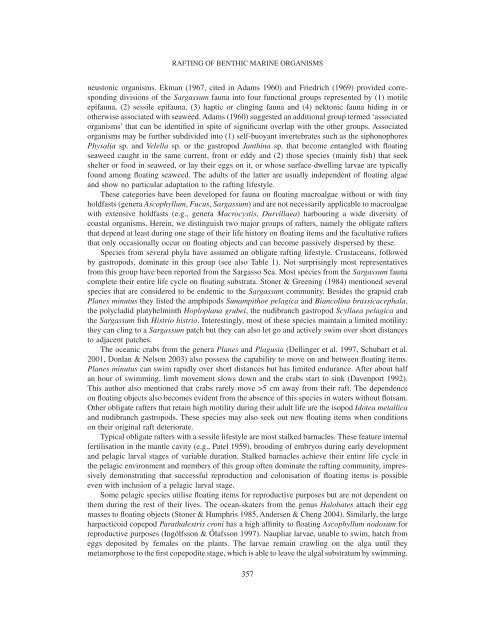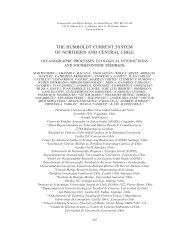The ecology of rafting in the marine environment - Bedim
The ecology of rafting in the marine environment - Bedim
The ecology of rafting in the marine environment - Bedim
Create successful ePaper yourself
Turn your PDF publications into a flip-book with our unique Google optimized e-Paper software.
RAFTING OF BENTHIC MARINE ORGANISMS<br />
neustonic organisms. Ekman (1967, cited <strong>in</strong> Adams 1960) and Friedrich (1969) provided correspond<strong>in</strong>g<br />
divisions <strong>of</strong> <strong>the</strong> Sargassum fauna <strong>in</strong>to four functional groups represented by (1) motile<br />
epifauna, (2) sessile epifauna, (3) haptic or cl<strong>in</strong>g<strong>in</strong>g fauna and (4) nektonic fauna hid<strong>in</strong>g <strong>in</strong> or<br />
o<strong>the</strong>rwise associated with seaweed. Adams (1960) suggested an additional group termed ‘associated<br />
organisms’ that can be identified <strong>in</strong> spite <strong>of</strong> significant overlap with <strong>the</strong> o<strong>the</strong>r groups. Associated<br />
organisms may be fur<strong>the</strong>r subdivided <strong>in</strong>to (1) self-buoyant <strong>in</strong>vertebrates such as <strong>the</strong> siphonophores<br />
Physalia sp. and Velella sp. or <strong>the</strong> gastropod Janth<strong>in</strong>a sp. that become entangled with float<strong>in</strong>g<br />
seaweed caught <strong>in</strong> <strong>the</strong> same current, front or eddy and (2) those species (ma<strong>in</strong>ly fish) that seek<br />
shelter or food <strong>in</strong> seaweed, or lay <strong>the</strong>ir eggs on it, or whose surface-dwell<strong>in</strong>g larvae are typically<br />
found among float<strong>in</strong>g seaweed. <strong>The</strong> adults <strong>of</strong> <strong>the</strong> latter are usually <strong>in</strong>dependent <strong>of</strong> float<strong>in</strong>g algae<br />
and show no particular adaptation to <strong>the</strong> <strong>raft<strong>in</strong>g</strong> lifestyle.<br />
<strong>The</strong>se categories have been developed for fauna on float<strong>in</strong>g macroalgae without or with t<strong>in</strong>y<br />
holdfasts (genera Ascophyllum, Fucus, Sargassum) and are not necessarily applicable to macroalgae<br />
with extensive holdfasts (e.g., genera Macrocystis, Durvillaea) harbour<strong>in</strong>g a wide diversity <strong>of</strong><br />
coastal organisms. Here<strong>in</strong>, we dist<strong>in</strong>guish two major groups <strong>of</strong> rafters, namely <strong>the</strong> obligate rafters<br />
that depend at least dur<strong>in</strong>g one stage <strong>of</strong> <strong>the</strong>ir life history on float<strong>in</strong>g items and <strong>the</strong> facultative rafters<br />
that only occasionally occur on float<strong>in</strong>g objects and can become passively dispersed by <strong>the</strong>se.<br />
Species from several phyla have assumed an obligate <strong>raft<strong>in</strong>g</strong> lifestyle. Crustaceans, followed<br />
by gastropods, dom<strong>in</strong>ate <strong>in</strong> this group (see also Table 1). Not surpris<strong>in</strong>gly most representatives<br />
from this group have been reported from <strong>the</strong> Sargasso Sea. Most species from <strong>the</strong> Sargassum fauna<br />
complete <strong>the</strong>ir entire life cycle on float<strong>in</strong>g substrata. Stoner & Green<strong>in</strong>g (1984) mentioned several<br />
species that are considered to be endemic to <strong>the</strong> Sargassum community. Besides <strong>the</strong> grapsid crab<br />
Planes m<strong>in</strong>utus <strong>the</strong>y listed <strong>the</strong> amphipods Sunampithoe pelagica and Biancol<strong>in</strong>a brassicacephala,<br />
<strong>the</strong> polycladid platyhelm<strong>in</strong>th Hoploplana grubei, <strong>the</strong> nudibranch gastropod Scyllaea pelagica and<br />
<strong>the</strong> Sargassum fish Histrio histrio. Interest<strong>in</strong>gly, most <strong>of</strong> <strong>the</strong>se species ma<strong>in</strong>ta<strong>in</strong> a limited motility:<br />
<strong>the</strong>y can cl<strong>in</strong>g to a Sargassum patch but <strong>the</strong>y can also let go and actively swim over short distances<br />
to adjacent patches.<br />
<strong>The</strong> oceanic crabs from <strong>the</strong> genera Planes and Plagusia (Dell<strong>in</strong>ger et al. 1997, Schubart et al.<br />
2001, Donlan & Nelson 2003) also possess <strong>the</strong> capability to move on and between float<strong>in</strong>g items.<br />
Planes m<strong>in</strong>utus can swim rapidly over short distances but has limited endurance. After about half<br />
an hour <strong>of</strong> swimm<strong>in</strong>g, limb movement slows down and <strong>the</strong> crabs start to s<strong>in</strong>k (Davenport 1992).<br />
This author also mentioned that crabs rarely move >5 cm away from <strong>the</strong>ir raft. <strong>The</strong> dependence<br />
on float<strong>in</strong>g objects also becomes evident from <strong>the</strong> absence <strong>of</strong> this species <strong>in</strong> waters without flotsam.<br />
O<strong>the</strong>r obligate rafters that reta<strong>in</strong> high motility dur<strong>in</strong>g <strong>the</strong>ir adult life are <strong>the</strong> isopod Idotea metallica<br />
and nudibranch gastropods. <strong>The</strong>se species may also seek out new float<strong>in</strong>g items when conditions<br />
on <strong>the</strong>ir orig<strong>in</strong>al raft deteriorate.<br />
Typical obligate rafters with a sessile lifestyle are most stalked barnacles. <strong>The</strong>se feature <strong>in</strong>ternal<br />
fertilisation <strong>in</strong> <strong>the</strong> mantle cavity (e.g., Patel 1959), brood<strong>in</strong>g <strong>of</strong> embryos dur<strong>in</strong>g early development<br />
and pelagic larval stages <strong>of</strong> variable duration. Stalked barnacles achieve <strong>the</strong>ir entire life cycle <strong>in</strong><br />
<strong>the</strong> pelagic <strong>environment</strong> and members <strong>of</strong> this group <strong>of</strong>ten dom<strong>in</strong>ate <strong>the</strong> <strong>raft<strong>in</strong>g</strong> community, impressively<br />
demonstrat<strong>in</strong>g that successful reproduction and colonisation <strong>of</strong> float<strong>in</strong>g items is possible<br />
even with <strong>in</strong>clusion <strong>of</strong> a pelagic larval stage.<br />
Some pelagic species utilise float<strong>in</strong>g items for reproductive purposes but are not dependent on<br />
<strong>the</strong>m dur<strong>in</strong>g <strong>the</strong> rest <strong>of</strong> <strong>the</strong>ir lives. <strong>The</strong> ocean-skaters from <strong>the</strong> genus Halobates attach <strong>the</strong>ir egg<br />
masses to float<strong>in</strong>g objects (Stoner & Humphris 1985, Andersen & Cheng 2004). Similarly, <strong>the</strong> large<br />
harpacticoid copepod Parathalestris croni has a high aff<strong>in</strong>ity to float<strong>in</strong>g Ascophyllum nodosum for<br />
reproductive purposes (Ingólfsson & Ólafsson 1997). Naupliar larvae, unable to swim, hatch from<br />
eggs deposited by females on <strong>the</strong> plants. <strong>The</strong> larvae rema<strong>in</strong> crawl<strong>in</strong>g on <strong>the</strong> alga until <strong>the</strong>y<br />
metamorphose to <strong>the</strong> first copepodite stage, which is able to leave <strong>the</strong> algal substratum by swimm<strong>in</strong>g.<br />
357










